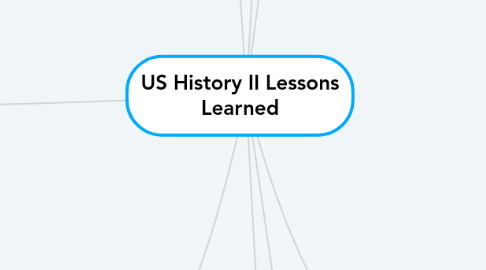
1. ***Economics:*** How has economics impacted America & Americans?
1.1. WWI Jobs
1.1.1. World War I helped jobs in America by creating a sense of need for the nation so more people started working to help their country
1.2. The Great Depression
1.2.1. The Stock Market crashed, and banks weren't able to repay people because they ran out of money to give back. Money deflated and the Great Depression began.
1.2.2. The New Deal was a system put in place by FDR that created jobs for Americans so they could survive.
1.2.3. Causes Stock Market Crash Overproduction + low demand No equal distribution of wealth Debt Increased Unemployment Low wages Dust Bowl
1.2.4. Effects People lose money Farmers struggle to produce New Deal: Relief, Recovery, Reform Banks closing People are losing houses Hoovervilles Jobs cant pay as much Debt increase
2. ***Migration*** What causes migration and how has it impacted America?
3. ***Leaders & Presidents*** What makes an effective or ineffective leader?
3.1. The Great Depression
3.1.1. President Hoover was often credited for the Great Depression, seeing as he was president at the time. People didn't like him, so when elections came around they voted for FDR because they liked what he stood for and he "wasn't Herbert Hoover."
3.2. The Vietnam War
3.2.1. Richard Nixon Nixon's policies overall during the Vietnam War were problematic and ended badly. His leadership as a president wasn't thought through enough in this time of need America needed to succeed in a failing war. From Nixon's mistakes future leaders of America realized what they should and shouldn't do to make sure that a war doesn't go wrong or uncontrollably out of hand too fast.
4. ***Government:*** What is the role and responsibility of the American government?
4.1. The Vietnam War
4.1.1. The Draft America's drafting process during this war was a disaster. The American public was strongly against the war and nobody wanted to fight in it because they knew it was near certain death because of just how badly America was handling the war. 30,000 men fled to Canada to escape the war and the draft, and there were 20,000 military deserters because this was just such a bad war to fight in.
5. ***Civil Rights:*** To what extent have the oppressed in America been able to attain an equality of life?
5.1. 1920's Women's Rights
5.1.1. In the 1920's women gained the right to vote due to the 19th amendment
5.1.2. Some women stopped getting married and having children so they wouldn't have to be weighed down by a family
5.1.3. Young women started dressing differently and acted more masculine and create a subculture of women called "flappers"
6. ***Technology*** How does technology impact society?
6.1. WWI Warfare
6.1.1. When there's a lot of new technology in society, we'll be ill-prepared for what's going to happen with it in war.
6.2. The Vietnam War
6.2.1. Napalm The napalm attacks used in the Vietnam War were a very bad idea because napalm was indiscriminate and burned anything it touched, including South Vietnamese and American troops in addition to North Vietnamese troops. The side effects of napalm were long lasting and serious, such as cancer, (which the government was aware of) but they went through with anyway America learned not to do attacks like napalm again without absolute certainty that it wouldn't hit any friendly troops.
7. ***Media*** To what extent does the media influence people? To what extent does the media mirror or reflect society?
7.1. The Red Scare
7.1.1. Joseph McCarthy used the media to spread the fear of Communism in the United States
7.1.2. The Hollywood Ten, major producers, had their careers (and lives) ruined by questioning due to McCarthy's antics
8. ***Foreign Relations*** How have foreign entanglements influence America?
8.1. World War I
8.1.1. When the US is involved in world afairs to a large extent, it is hard to stay neutral. If a major conflict breaks out
8.1.2. Forming allies can draw the country into a broader conflict
8.1.3. Main Militarism Alliances Imperialism Nationalism Archduke, Franz Ferdinand of austria assassinated by Serbia American entry into WWI WWI modern warfare League of Nations and failure
8.2. World War II
8.2.1. Holocaust Attack on Poland Jewish Persecution Atomic bomb Pearl Harbor Stalingrad = turning point of the war Fall of France M.A.G.N.E.T.T. Militarism Alliances Great Depression Nationalism Expansionism Treaty of Versailles Totalitarianism Pivotal battles The Battle of France Operation Torch The Invasion of Normandy The Battle of Stalingrad The Battle of the Bulge The Battle of Berlin The Battle of Guadalcanal Battle of Midway The Battle of Okinawa Pearl Harbor
8.3. The Vietnam War
8.3.1. The Invisible Enemy American troops couldn't tell the North Vietnamese and the South Vietnamese apart based on looks because they all looked similar and their uniforms were identical because they were technically from the same country in the first place. This means American forces could enter a village or encampment in Vietnam and they couldn't tell if it was friend or foe, so they could either kill innocents or give mercy to North Vietnamese, where in which they would be immediately killed. America learned that they needed to find ways to differentiate uniforms and standards between two armies so there wouldn't be needless or accidental bloodshed.
8.3.1.1. New node
8.3.2. Paris Peace Accords In 1973, when the Paris Peace Accords were signed by America and North Vietnam, America's involvement in the war was ended, but North Vietnam blindsided America by invading the South once America had removed troops, which caused America to rush and evacuate as many South Vietnamese as possible before the takeover was complete. This taught America to be more careful with peace treaties and to kind of keep tabs on the enemy for a while to make sure they aren't going to pull anything like North Vietnam did ever again.
8.3.2.1. New node

